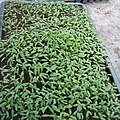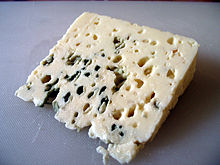Prick out

Pikieren (from French piquer "sting") originally referred to in the military the stabbing with a spear (the pike) by the pikeman . In today's parlance, the term is mainly used in horticulture and food .
In horticulture, pricking means transplanting seedlings that are too close together at greater distances (singling out). During cheese production , oxygen is added to the mold cheese by pricking in order to encourage the formation of molds . In kitchens jargon called pricking a procedure be introduced in the fabrics, or simple "holes".
horticulture
Purpose of pricking
Pricking gives the growing plants more space. They are moved as soon as the first correct pairs of leaves appear after the first cotyledons . Removing it from the substrate (soil) leads to root damage, which stimulates the plant to increased root growth. The use of high-quality pelleted seeds and single - grain seeds means that time-consuming pricking out is avoided in large nurseries .
A round stick that tapers to a point, the prick stick, is usually used for pricking . Most pricking sticks are made of plastic, wood ( pricking wood ) or metal and are about 18 centimeters long. However, commercially available wooden shish kebab sticks are in no way inferior to professional pricking sticks and are usually easier to obtain.
seperate
First the plants are separated from each other. You can use the pricking stick for this. You lift the rooted plants at one corner and take them out of the growing container in one piece. To avoid damage from wilting , the seedlings are only loosened in small portions. The individual plants are separated, sick ones or those with rotten spots are sorted out. The roots of the healthy plants are shortened and adapted to the planting hole.
Prick in
With the thick end of the pricking stick, a hole is pressed into the crumbly soil of the new plant container and the plant is placed in the hole, with the roots lying under the earth. The root is placed vertically in the pre-set hole. A bent root, the end of which points to the side or up, leads to undesirable growth stoppage. If the roots are too long, it is therefore more advantageous to shorten the roots a little. Then the hole around the plant is carefully closed with the thin end of the pricking stick and the soil is pressed on from the side. The distance between the plants depends on the species . The minimum distances for annual and biennial garden plants are three to five centimeters. In the end it is poured.
Series of pictures
- Prick out tomato seedlings
Food
Cheese making
To encourage the formation of mold, certain types of cheese are pricked with wide needles during the ripening process, so that oxygen can penetrate the cheese through the needle channels. Of the 130,000 species of fungi, only a few can be used for dairy farming and are therefore suitable for the production of cheese as ripening organisms. These mushroom species used in the dairy industry differ from harmful cultures in that they only give the cheese their specific aromas, but are completely harmless to the human organism. They are therefore classed as noble mushrooms and are classified as particularly valuable.
In particular, the group of green and blue cheese is considered the noblest culture. It was always represented by the countries of origin as a royal class. Examples are England's Blue Stilton or France's Roquefort . The noble mold culture is mostly referred to as Penicillium . In modern cheese production, this is added in liquid form. The mushroom formation is then promoted and accelerated by pricking. Originally the mold was cultivated in special bread, which was dried, pulverized and added to the curd.
Pricking meat
When pricking, spicy liquids ( marinades or curing lake) are introduced into large pieces of meat with a curing syringe or lake syringe so that they are marinated evenly from the inside. When curing , the faster, more uniform rapid curing and the lower weight loss (compared to dry curing ) are advantageous.
Pricking dough
The dough is pierced evenly with a fork, chipping needle or pike needles. The piercing causes more even baking and results in a loose base, as more air can be baked into the dough.
Tailoring
In tailoring, pricking means to pierce a stronger material with a seam only from the back in an arc shape, in order to keep the seam invisible at the front.
Saying "be piqued"
The saying "to be pricked" can be based on the technique of pricking. The origin is the French verb piquer , which can be translated as "sting", but also as "annoy" or "irritate".
A piquant person feels offended, annoyed, neglected or in some other way not sufficiently valued and withdraws, shows this outwardly and wants to achieve that one apologizes to him or turns to another way. Insofar as this claim is unjustified, the others assume that it is “piqued” (see also insulted liver sausage ).







